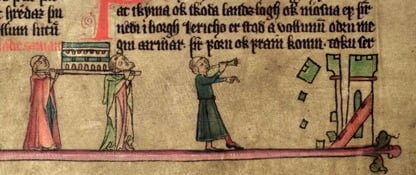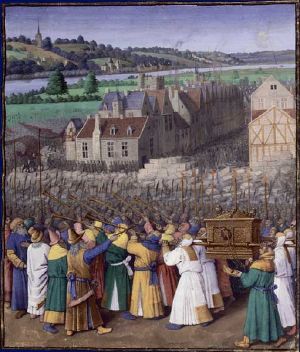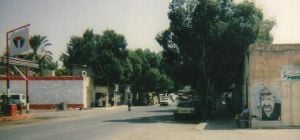Difference between revisions of "Jericho" - New World Encyclopedia
(epname, claimed, cat) |
m ({{Contracted}}) |
||
| Line 1: | Line 1: | ||
| − | {{Claimed}} | + | {{Claimed}}{{Contracted}} |
| − | {{ | + | {{otheruses1|the city in the West Bank|Jericho}} |
[[Image:Prise de Jéricho.jpg|thumb|The Taking of Jericho, by [[Jean Fouquet]]]] | [[Image:Prise de Jéricho.jpg|thumb|The Taking of Jericho, by [[Jean Fouquet]]]] | ||
[[Image:Jerico1.JPG|thumb|Near central Jericho, November 1996]] | [[Image:Jerico1.JPG|thumb|Near central Jericho, November 1996]] | ||
Revision as of 16:12, 29 January 2007
- This article is about the city in the West Bank. For other uses of the term, see Jericho (disambiguation).
Jericho (Arabic أريحا ▶, ʼArīḥā; Hebrew יְרִיחוֹ ▶, Standard Yəriḥo Tiberian Yərîḫô / Yərîḥô; meaning "fragrant"[1]. Greek Ἱεριχώ = Ἱερή ἠχώ, Hierē ēchō - Holy echo[citation needed]) is a town in the West Bank, Palestine near the Jordan River. Jericho has a population of approximately 19,000.[2] It is believed by some to be the oldest continuously occupied settlement in the world.[3] The current mayor of Jericho is Hassan Saleh.
Recent history
The present city was captured by Israel after the Six-Day War in 1967. It was the first city handed over to Palestinian Authority control in 1994, in accordance with the Oslo accords. After a period of Israeli readministration, it was returned to the Palestinian Authority on 16 March 2005.
Jericho prison incident
On March 14, 2006, the Israel Defense Forces took captive six inmates from a Jericho prison following a 10-hour siege. The IDF said the reason for taking the prisoners, who were wanted for participation in the assassination of Israeli tourism minister Rehavam Zeevi, was to keep them from being released. Both sides of the siege were armed and at least two people were killed and 35 wounded in the incident.
Synagogue
An ancient synagogue was discovered in Jericho in 1936. It has been controlled by Israel since the Six Day War, but after the Oslo Accords and especially the Al Aqsa Intifada it has been a source of conflict.
Archaeology
Three separate settlements have existed at or near the current location for more than 11,000 years. The position is on an east-west route north of the Dead Sea.
The first archaeological excavations of the site were made by Charles Warren in 1868. Ernst Sellin and Carl Watzinger excavated Tell es-Sultan and Tulul Abu el-'Alayiq between 1907-1909 and in 1911. John Garstang excavated between 1930 and 1936. Extensive investigations using more modern techniques were made by Kathleen Kenyon between 1952 and 1958. Lorenzo Nigro and Nicolo Marchetti conducted a limited excavation in 1997. Later that same year, Dr. Bryant Wood also made a visit to the site to verify the findings of the earlier 1997 team.
Tell es-Sultan
The earliest settlement was located at the present-day Tell es-Sultan (or Tell Sultan), a couple of kilometers from the current city. In Arabic, tell means "mound" — consecutive layers of habitation built up a mound over time, as is common for ancient settlements in the Middle East and Anatolia. Jericho is the type site of the Pre-Pottery Neolithic A (PPN A) and B.
The habitation has been classed into several phases:
Natufian
Epipaleolithic — construction at the site apparently began before the invention of agriculture, with construction of stone of the Natufian culture structures beginning earlier than 9000 B.C.E.
PPN A
Pre-Pottery Neolithic A, 8350 B.C.E. to 7370 B.C.E. Sometimes it is called Sultanian. The site is a 40,000 square metre settlement surrounded by a stone wall, with a stone tower in the centre of one wall. This is so far the oldest wall ever to be descovered[1], thus suggesting some kind of social organization, even if based on charisma. The town contained round mud-brick houses, yet no street planning [2]. The 400-2000 dwellers used domesticated emmer wheat, barley and pulses and hunted wild animals.
PPN B
Pre-Pottery Neolithic B, 7220 B.C.E. to 5850 B.C.E. (but carbon-14-dates are few and early). Expanded range of domesticated plants. Possible domestication of sheep. Apparent cult involving the preservation of human skulls, with facial features reconstructed from plaster and eyes set with shells in some cases.
After the PPN A settlement-phase there was a settlement hiatus of several centuries, then the PPN B settlement was founded on the eroded surface of the tell. The architecture consisted of rectilinear buildings made of mudbricks on stone foundations. The mudbricks were loaf-shaped with deep thumb prints to facilitate bounding. No building has been excavated in its entirety. Normally, several rooms cluster around a central courtyard. There is one big room (6.5 x 4 m and 7 x 3 m) with internal divisions, the rest are small, presumably used for storage. The rooms have red or pinkish terrazzo-floors made of lime. Some impressions of mats made of reeds or rushes have been preserved. The courtyards have clay floors.
Kathleen Kenyon interpreted one building as a shrine. It contained a niche in the wall. A chipped pillar of volcanic stone that was found nearby might have fit into this niche.
The dead were buried under the floors or in the rubble fill of abandoned buildings. There are several collective burials, not all the skeletons are completely articulated, which may point to a time of exposure before burial. A skull cache contained seven skulls. The jaws were removed, the face covered with plaster, cowries were used for eyes. All in all, ten skulls were found. Modelled skulls were found in Tell Ramad and Beisamoun as well.
Other finds
- Flints: arrowheads (tanged or side-notched), finely denticulated sickle-blades, burins, scrapers, a few tranchet axes. 1% obsidian, Ciftlik and green obsidian from unknown source.
- ground stone: querns, hammerstones, a few ground-stone axes made of greenstone. Dishes and bowls carved from soft limestone. Spindle whorls made of stone and maybe loom weights.
- Bone Tools: Spatulae and drills
- stylised anthropomorphic plaster figures, almost life-size
- Anthropomorphic and theriomorphic clay figurines
- shell and malachite beads
Pottery Neolithic A and B
Late 4th millennium B.C.E. Jericho was occupied during Neolithic 2 and the general character of the remains on the site link it culturally with Neolithic 2 sites in the West Syrian and Middle Euphrates groups. There are the rectilinear mud-brick buildings and plaster floors.
Bronze age
Walls of Jericho
The Biblical account of the destruction of Jericho is found in the Book of Joshua. The Bible describes the destruction as having proceeded from the actions of Joshua, Moses' successor. The exodus is usually dated to the 13th century B.C.E. (based on Ussherian calculation) − according to interpretation of archeological evidence from the Merneptah Stele followed by new settlements in the next century. At that time the Pharaoh of Egypt would be Ramses II. Alternatively, the exodus is dated to the 15th century B.C.E. − according to a prevailing Christian reckoning of biblical chronology, which is synchronized with several ancient calendars with astronomical observation. At that time the Pharaoh would be Thutmose III (1490-1430). Neither biblical chronology matches the popular interpretation of the archeological evidence at Jericho.
A destruction of Jericho's walls dates archeologically to around 1550 B.C.E. in the 16th century B.C.E. at the end of the Middle Bronze Age, by a siege or an earthquake in the context of a burn layer, called City IV destruction. Opinions differ as to whether they are the walls referred to in the Bible. According to one biblical chronology, the Israelites destroyed Jericho after its walls fell out around 1407 B.C.E. at the end of the 15th century. Originally, John Garstang's excavation in the 1930s dated Jericho's destruction to around 1400 B.C.E., in confirmation, but like much early biblical archaeology, his work became criticised for using the Bible to interpret the evidence rather than letting the facts on the ground draw their own conclusions. Kathleen Kenyon's excavation in the 1950s redated it to around 1550 B.C.E., a date that most archeologists support.[4][5] In 1990, Bryant Wood critiqued Kenyon's work after her field notes became fully available. Observing ambiguities and relying on the only available carbon dating of the burn layer, which yielded a date of 1410 B.C.E. plus or minus 40 years, Wood dated the destruction to this carbon dating, confirming Garstang and the biblical chronology. Unfortunately, this carbon date was itself the result of faulty calibration. In 1995, Hendrik J. Bruins and Johannes van der Plicht used high-precision radiocarbon dating for eighteen samples from Jericho, including six samples of charred cereal grains from the burn layer, and overall dated the destruction to an average 1562 B.C.E. plus or minus 38 years.(Radiocarbon Vol. 37, Number 2, 1995.)[3][4] Kenyon's date of around 1550 B.C.E. is more secure than ever. Notably, many other Canaanite cities were destroyed around this time.
Scholars who link these walls to the biblical account must explain how the Israelites arrived around 1550 B.C.E. but settled four centuries later and devise a new biblical chronology that corresponds. The current opinion of many archaeologists is in stark contradiction to the biblical account.
The widespread destructions of the 16th century B.C.E. are often linked with the expulsion of the Hyksos from Egypt around this time. Interestingly, the 1st-century historian Josephus, in Against Apion, identified the Exodus of Israelites according to the Bible as the Expulsion of the Hyksos according to the Egyptian texts. Nevertheless, Josephus's historical inaccuracies should be considered and his word not taken as law.
A few scholars follow the controversial new chronology of David Rohl, which postulates that the entire mainstream Egyptian chronology is 300 years misplaced; with the conseqence that, among other things, the exodus would be dated to the 16th or 17th century B.C.E., and hence the archaeological record on Jericho would be much more aligned with the biblical account. Despite this, a number of literalist Christians, most prominently the respected Egyptologist Kenneth Kitchen, have vehemently attacked Rohl's chronology, since it introduces a number of other problems and issues (such as identifying the biblical Shishak as Ramses II, rather than the far more obviously named Shoshenq). The opinion of some archaeologists is in stark contradiction to the biblical account.
Tulul Abu el-'Alayiq
A later settlement spanned the Hellenistic, New Testament, and Islamic periods, leaving mounds located at Tulul Abu el-'Alayiq, 2 km west of modern er-Riha. It is suspected that this settlement was very violent.
Biblical references
Jericho is mentioned in the Jewish Hebrew Bible (the Christian Old Testament), over 70 times. Here are some examples:
- Prior to Moses' death, God is described as showing him the Promised Land in the Book of Deuteronomy with Jericho as a point of reference: "And Moses went up from the plains of Moab unto mount Nebo, to the top of Pisgah, that is over against Jericho. And the Lord showed him all the land, even Gilead as far as Dan" (Deuteronomy 34:1). [5]

- The Book of Joshua describes the famous siege of Jericho, claiming that it was circled seven times by the ancient Children of Israel until its walls came tumbling down [6], after which Joshua cursed the city: "And Joshua charged the people with an oath at that time, saying: 'Cursed be the man before the Lord that riseth up and buildeth this city, even Jericho; with the loss of his first-born shall he lay the foundation thereof, and with the loss of his youngest son shall he set up the gates of it'". (Joshua 6:26).
- The Book of Jeremiah describes the end of the Judean king Zedekiah when he is captured in the area of Jericho: "But the army of the Chaldeans pursued after them, and overtook Zedekiah in the plains of Jericho; and when they had taken him, they brought him up to Nebuchadnezzar king of Babylon to Riblah in the land of Hamath, and he gave judgment upon him." [7] (Jeremiah 39:5).
See also
- History of ancient Israel and Judah
- History of pottery in the Southern Levant
- Jericho (TV Series)
ReferencesISBN links support NWE through referral fees
- ↑ Strong's Bible Dictionary
- ↑ "Jericho", Columbia Electronic Encyclopedia
- ↑ "Jericho", Minnesota State University, Mankato
- ↑ Israel Finkelstein, The Bible Unearthed
- ↑ Sturgis, Matthew and with McCarthy, John (2001). It Ain't Necessarily So. London:Hodder Headline, pp 56-59. ISBN 0-7472-4506-1.
- Kenyon, Kathleen (1957). Digging Up Jericho.
- Finkelstein, Israel and Silberman, Neil Asher (2002). The Bible Unearthed. Touchstone. ISBN 0-684-86913-6.
- Miller, Edward B. (2001). AN OASIS OR JUST A MIRAGE: THE JERICHO CASINO AND THE FUTURE OF THE ISRAELI PALESTINIAN PEACE PROCESS.
External links
- Telepherique & Sultan Tourist Center
- Jericho Municipality Official Website
- Ancient Jericho (Tell Sultan)
- Resources on Biblical Archaeology
- Archaelogical History of Jericho
- The walls of Jericho fell in 1550 B.C.E.
Template:Cities of the Palestinian Territories
ar:أريحا bs:Jerihon bg:Йерихон ca:Jericó da:Jeriko de:Jericho es:Jericó (Cisjordania) fa:اریحا fr:Jéricho hr:Jerihon it:Gerico he:יריחו lv:Jērika lt:Jerichonas nl:Jericho ja:エリコ pl:Jerycho pt:Jericó ru:Иерихон sh:Jerihon fi:Jeriko sv:Jeriko zh:杰里科
Credits
New World Encyclopedia writers and editors rewrote and completed the Wikipedia article in accordance with New World Encyclopedia standards. This article abides by terms of the Creative Commons CC-by-sa 3.0 License (CC-by-sa), which may be used and disseminated with proper attribution. Credit is due under the terms of this license that can reference both the New World Encyclopedia contributors and the selfless volunteer contributors of the Wikimedia Foundation. To cite this article click here for a list of acceptable citing formats.The history of earlier contributions by wikipedians is accessible to researchers here:
The history of this article since it was imported to New World Encyclopedia:
Note: Some restrictions may apply to use of individual images which are separately licensed.



